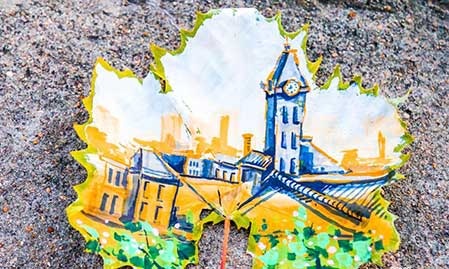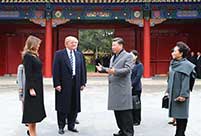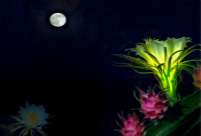

Long Life, Affluent Life and Great Education—Guangzhou’s HDI (Human Development Index) Ranks on Top of the Nation. Guangzhou’s HDI stood at 0.869 in 2016, continuing to lead all Chinese cities, based on an assessment on life expactancy, educational level and life quality according to the China Urban Sustainability Report 2016: Measuring Ecological Inputs and Human Development, released by the United Nations Development Program.
Population
In 2016, Guangzhou was home to 14,043,500 permanent residents, up 542,400 or 4.02%. The registered household population totaled 8,704,900, representing a year-on-year increase of 163,000 or 1.91%, of which 137,275 were registered newborns. The sex ratio of the newborns of the registered household population was 112.84 in the same year.
Migrant population. In 2016, the city had the registered migrant population of 8,889,700, up 11.96% year on year. In 2016, Guangzhou promulgated and implemented the Guangzhou Action Plan on Integration of Migrant People 2016-2020, guiding the migrants to integrate into the local society. The city continued to push the Points System for Household Registration, increasing the quota to 6,000 in the same year. The city also spared no efforts in pushing the equalization work of basic public services for the migrant people including the application on leasing public rental housing based on the points system, the compulsory education for their children living with them and college/high school entrance examination for their children studying in Guangzhou.
Ethnicities & Religions
At present, Guangzhou has 56 ethnic groups, with the combined population of ethnic minorities reaching over 700,000, belonging to 55 ethnic minorities. There are about 88,000 registered residents belonging to the ethnic minorities, including mainly those from Zhuang, Hui, Man, Tujia and Yao. The migrant population of the ethnic minorities stands at approximately 630,000, including mainly those from Zhuang, Hui, Tujia, Miao, Yao and Dong. There are 4 ethnic organizations established at the municipal level, 10 at the district level and 1 at the street/town level in Guangzhou.
Huaisheng Mosque. Huaisheng Mosque, built in the early Tang Dynasty, is the first Islamic mosque in China since Islam entered the nation. The mosque was constructed in memory of Muhammad, the "Holy Prophet" and founder of Islam. Hence the name of the mosque, Huaisheng, namely in memory of the “Holy Prophet”. The Guangta Tower, located at the south-western corner of the mosque, is the oldest existing “minaret” among all mosques around the world.
Traditional Folk Customs
Canton Temple Fair: The Canton Temple Fair is a local folk custom celebrated in the Yuexiu District of Guangzhou. During the Latern Festival, people will hold a large variety of activities at the temple fair to create the festival atmosphere including lantern shows, food festival, lion dancing, kungfu, puppet shows and praying for blessings.
Flower Fair. The Cantonese people have enjoyed the tradition of attending the flower fair for over 100 years. The city’s streets are adorned by fresh and blooming flowers each year from the 28th day of the 12th lunar month to the eve of the Spring Festival, and when the citizens rejoice amid beautiful flowers, laughter can be heard everywhere. The flower fair has undergone great reforms since 2013, when its time was extended to the fifteenth day of the first lunar month. The overall people flow of the 2016 Guangzhou Traditional Flower Fair reached 5.1 million person times, with the transaction of 101 million yuan.
The Magpie Festival. The Magpie Festival, originated in the Han Dynasty, is also called “Birthday of the Seventh Sister”, “Birthday of the Seventh Lady”, “Setting up the Shrine for the Seventh Lady” or “Worshipping the Seventh Lady” by the local Cantonese people. As a Guangzhou folk custom with special flavors, it has been included into the third batch of National Intangible Cultural Heritage List.
Traditional Architecture
Guangzhou attracted the attention of the whole nation during the per-modern history when it witnessed huge strides-forward in social and economic development as Chinese and western cultures integrated and clashed here at the same time. Hence, Guangzhou has become one of the Chinese cities with the most diversified styles of architecture during the pre-modern history and its architectures with rich regional characteristics reflected the glory and evolution of the city in a great age.
Qilou (Arcade Architecture). Guangzhou city started the construction of modern roads in the early 20th century when an arcade building, known as Qilou to the locals, came into being through the integration of the gallery of classic western architecture with the traditional architecture of Lingnan. Qilou was usually built in front of the buildings and over the pavement, thus creating a long pedestrian corridor by linking the different buildings. This architecture became an instant hit in the city, creating the major style of the streets and a unique romantic lifestyle of the Cantonese people because it catered to the subtropical climate of the city, namely scorching sunshine and sudden rainfalls, as well as the need of the urban buildings to rise higher and the urge of local businesses to develop and prosper together.
Xiguan Mansion. Xiguan Mansion, the private houses built by local rich families at Xiguan during the late Qing Dynasty, is scattered in the area, boasting rich Lingnan flavors. Most of the Xiguan Mansions, 2 or 3-storey brick and wood structures, usually face south and have slope roofs. From south to north, there is the porch, the courtyard, the sedan room and the main hall, etc. The main gate is composed of the “corner door”, the “bar door” and the main door. The exterior wall on the front side is usually made of elegant gray bricks while the wainscot was of white granite. Most of the interior part is decorated by wood carvings and architectural components with rich Lingnan flavors such as Manchu windows and sill wall windows.
Dongshan Modern Building. Many returned Overseas Chinese people started to buy land and construct modern buildings in the Dongshan area in 1915, followed by military and government officials of the Republic of China period, who also built their villas and official mansions in the area. These villas are usually two or three-storey high and quite large as far as construction area is concerned, boasting diversified plane layout as well as front yards and back yards. The architectural style of these garden-villas is usually deeply affected by the western style, usually in the classic column type although a few are still traditional Chinese buildings. The interior decoration is usually quite good, boasting quality cement flower tile floors, and the porch is built with high quality materials such as waterstone spraying. The “Young Lady of Xiguan” and the “Young Master of Dongshan” became both a favorite topic at the time and Guangzhou’s unique cultural symbol, reflecting the integration of Chinese and western cultures and the glamorous urban life in Guangzhou.
Folk Culture
The Lingnan area has been united with the central regions of China since the Qin and Han dynasties while war brought the civiliation of the central regions to the Pearl River area as well, making up the main body of Lingnan Culture as well as gradually creating stable styles in the areas of poem, drawing, art and culture. Lingnan Painting School, Guangdong Music and Cantonese Opera, the most renowned of all local art forms, are better known as the “Three Art Treasures of Lingnan”. Guangzhou Glazed Porcelain, Guangzhou Embroidery and Guangzhou Carving are also art treasures of Guangzhou folk culture.
Cantonese Opera. Cantonese Opera is one of the most influential opera genres in South China. The opera is usually put on play in Hong Kong and Macao but reaches as far as Southeast Asia, the Americas and Europe. As Sit Kok Sin, the celebrated “King of Cantonese Opera” put it: wherever there is smoke and fire (which people cook their food with), there is a Cantonese Opera Troupe. Cantonese Opera has spread far and wide after over three hundred years of history. Actors of the opera set up their own guild, namely the Viburnum Hall, as early as the Wanli Reign of the Ming Dynasty.
Guangdong Music. This instrumental music, popular in the Pearl River Delta, has crisp and bright tones, elegant and smooth melodies as well as lively and cheerful rhythms. Professional musicians composed Guangdong music pieces through learning from the music cultures from three regions including the Ancient Music of the Central Plain, Kunqu Opera tunes of Suzhou and popular tunes of the Jiangnan area, and through integrating the characteristics of the Cantonese dialect. The music first came into being in the late Qing Dynasty, entered its prime during the early Republic of China period, and it is still developing at present, boasting special regional flavors.
Lingnan Painting School. Lingnan Painting School, a branch of the Chinese art of drawing, was founded by Gao Jianfu and Gao Qifeng, who are brothers, and Chen Shuren, their classmate. Lingnan Painting School attaches great importance to sketching, integrating the advantages of Chinese and western painting schools. The Lingnan Painting School not only occupies an important position in domestic painting circles but also enjoys extensive influence overseas. It is a new form of Chinese folk painting, which has developed on the basis of inheriting Chinese folk customs and integrating the acheivements of domestic and overseas painting schools and improving them in the process.
Guangzhou Carving. Guangzhou Carving is gifted with dignified, mellow, lively and elegant styles thanks to over one thousand years of history and hundreds of years of improvement on its skills. It is unique in depicting traditional Chinese auspicious patterns. Foreign visitors to Guangzhou in the old times, stunned by the magical hollowed-out and three-dimensional carving techniques of Guangzhou Carving artifacts, made them a top choice as gifts for their family and friends. Both the Daxin “Ivory Street”, once a popular destination for domestic and overseas buyers, and the present day Daxin Ivory Plant, are the greatest historical legacy and symbols of Guangzhou Carving.
Guangzhou Embroidery. Originated in the Tang Dynasty, Guangzhou Embroidery is the glamorous “Sister Art” of Guangzhou Glazed Porcelain, known as the “Top Four Embroideries” of China, together with Suzhou Embroidery, Hunan Embroidery and Sichuan Embroidery. Guangzhou Embroidery is known for its precise and refined craftsmanship, diversified needle work and rich colors, thus becoming a bright pearl of Chinese folk art. It was not only a most popular artifact in the Chinese imperial court, but also introduced into the royal courts of “foreigners”, becoming a fashion in Europe and America at a time.
Guangzhou Glazed Porcelain. Guangzhou Glazed Porcelain, also called “Foreign Glazed Porcelain ” or “Guangzhou Zhijin Color Porcelain”, is known for its compact composition, rich colors and splendid decoration. There was even a poem to praise it in the old times, which said “Ten Thousand Gold Threads Woven on White Jade, Spring Flowers Blooming on Silver Porcelain”. This art form has an ever-lasting glamor.
Guangzhou Porcelain has endured over 300 years of time and changed from a world-renowned handicraft to a Chinese Intangible Cultural Heritage. Time may have changed but generations after generations of Guangzhou Glazed Porcelain craftsmen have followed this ancient trade year after year without regrets. People who understand Guangzhou Glazed Porcelain will also get a better understanding of Guangzhou and the history of the once prosperous porcelain trade over sea.
 Chinese brand becomes largest handset provider in Africa
Chinese brand becomes largest handset provider in Africa Busty Lais Ribeiro steals the Victoria's Secret Fashion Show
Busty Lais Ribeiro steals the Victoria's Secret Fashion Show Highlights Victoria's Secret Fashion Show in Shanghai
Highlights Victoria's Secret Fashion Show in Shanghai China's first cross-sea rail-road bridge takes shape
China's first cross-sea rail-road bridge takes shape A fancy world painted on fallen leaves
A fancy world painted on fallen leaves Photo album: Xi-Trump meeting in Beijing
Photo album: Xi-Trump meeting in Beijing Pitaya flower: blooms for one night, yields delicious fruit
Pitaya flower: blooms for one night, yields delicious fruit Hol Xil: Ideal habitat for Tibetan animals
Hol Xil: Ideal habitat for Tibetan animals Skywalk made of glass opens in Guizhou's Yuntaishan
Skywalk made of glass opens in Guizhou's Yuntaishan Top 10 most sustainable cities in China
Top 10 most sustainable cities in China Top 10 European patent applicants in 2016
Top 10 European patent applicants in 2016 The power of 'She' in China
The power of 'She' in China Seven most beautiful art museums in China
Seven most beautiful art museums in China Cyber rumors must be effectively addressed
Cyber rumors must be effectively addressed
 Migrant workers leave Beijing in droves amid evictions enacted following deadly fire
Migrant workers leave Beijing in droves amid evictions enacted following deadly fire
 Profits before pupils
Profits before pupils
 Is Weibo still the best choice for young Chinese when it comes to social media platforms?
Is Weibo still the best choice for young Chinese when it comes to social media platforms?
Day|Week